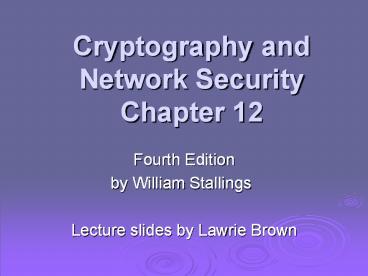Cryptography and Network Security Chapter 12 - PowerPoint PPT Presentation
Title: Cryptography and Network Security Chapter 12
1
Cryptography and Network SecurityChapter 12
- Fourth Edition
- by William Stallings
- Lecture slides by Lawrie Brown
2
Hash and MAC Algorithms
- Hash Functions
- condense arbitrary size message to fixed size
- by processing message in blocks
- through some compression function
- either custom or block cipher based
- Message Authentication Code (MAC)
- fixed sized authenticator for some message
- to provide authentication for message
- by using block cipher mode or hash function
3
Hash Algorithm Structure
4
Secure Hash Algorithm
- SHA originally designed by NIST NSA in 1993
- was revised in 1995 as SHA-1
- US standard for use with DSA signature scheme
- standard is FIPS 180-1 1995, also Internet
RFC3174 - nb. the algorithm is SHA, the standard is SHS
- based on design of MD4 with key differences
- produces 160-bit hash values
- recent 2005 results on security of SHA-1 have
raised concerns on its use in future applications
5
Revised Secure Hash Standard
- NIST issued revision FIPS 180-2 in 2002
- adds 3 additional versions of SHA
- SHA-256, SHA-384, SHA-512
- designed for compatibility with increased
security provided by the AES cipher - structure detail is similar to SHA-1
- hence analysis should be similar
- but security levels are rather higher
6
SHA-512 Overview
7
SHA-512 Compression Function
- heart of the algorithm
- processing message in 1024-bit blocks
- consists of 80 rounds
- updating a 512-bit buffer
- using a 64-bit value Wt derived from the current
message block - and a round constant based on cube root of first
80 prime numbers
8
SHA-512 Round Function
9
SHA-512 Round Function
10
Keyed Hash Functions as MACs
- want a MAC based on a hash function
- because hash functions are generally faster
- code for crypto hash functions widely available
- hash includes a key along with message
- original proposal
- KeyedHash Hash(KeyMessage)
- some weaknesses were found with this
- eventually led to development of HMAC
11
HMAC
- specified as Internet standard RFC2104
- uses hash function on the message
- HMACK Hash(K XOR opad)
- Hash(K XOR ipad)M)
- where K is the key padded out to size
- and opad, ipad are specified padding constants
- any hash function can be used
- eg. MD5, SHA-1, RIPEMD-160, Whirlpool
12
HMAC Overview
13
HMAC Security
- proved security of HMAC relates to that of the
underlying hash algorithm - attacking HMAC requires either
- brute force attack on key used
- birthday attack (but since keyed would need to
observe a very large number of messages) - choose hash function used based on speed verses
security constraints
14
CMAC
- previously saw the DAA (CBC-MAC)
- widely used in govt industry
- but has message size limitation
- can overcome using 2 keys padding
- thus forming the Cipher-based Message
Authentication Code (CMAC) - adopted by NIST SP800-38B
15
CMAC Overview
16
Summary
- have considered
- some current hash algorithms
- SHA-512
- HMAC authentication using hash function
- CMAC authentication using a block cipher































